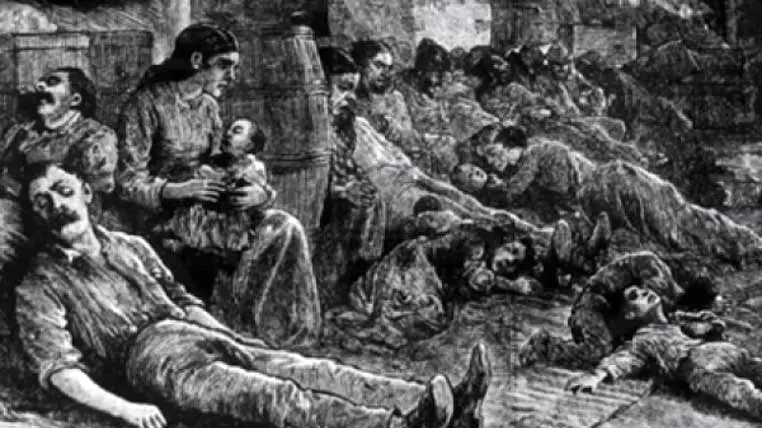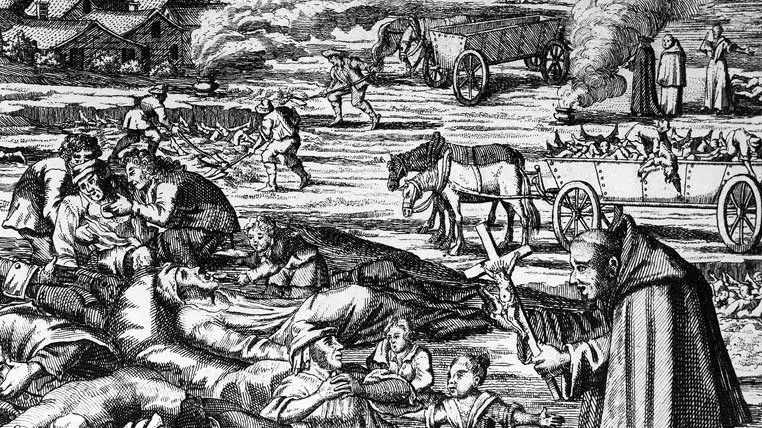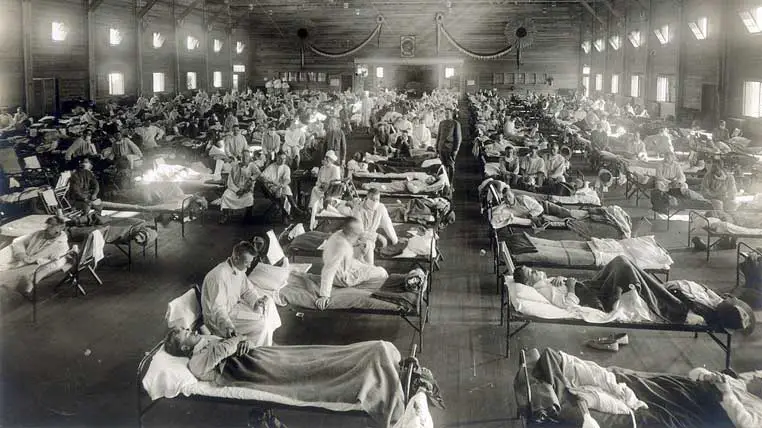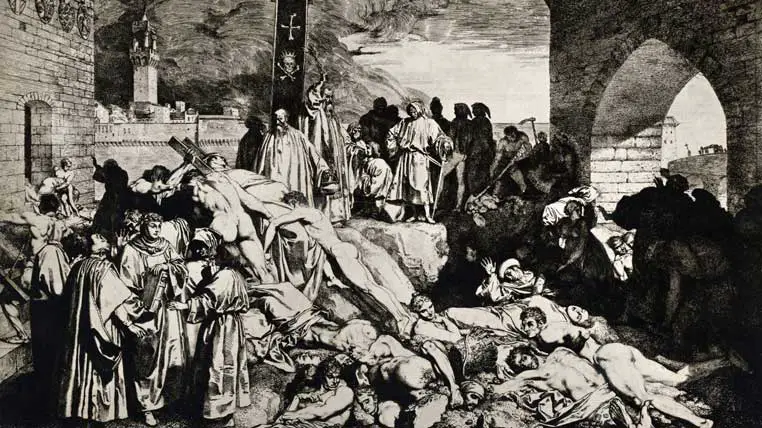The history of humanity is marked by the emergence of diseases that have wreaked havoc on a global scale.
Among them, the worst pandemics in history have taken an especially heavy toll on human life, leaving behind a trail of suffering and devastation.
Let us take a closer look at the top 11 worst pandemics in history and their profound impact.

The Sixth Cholera Pandemic (1910-1911)
The sixth cholera pandemic (1910-1911) is history’s 11th most deadly pandemic.
Just like the five cholera pandemics that preceded it, the reappearance of the deadly virus in 1910 caused the death of a considerable number of people in India, over 800,000, before spreading to the Middle East, North Africa, Eastern Europe, and Russia.
By the end of 1911, the pandemic had reached the United States, but the American health authorities were prepared and acted quickly to isolate and quarantine infected individuals.
This response limited the spread of the disease in the United States, where only 11 deaths were reported.
From 1911 to the present, cholera cases reported worldwide have decreased significantly, but the infection still causes many deaths, even today, in India and some African countries.

Worst Pandemics in History - The Flu Pandemic (1889-1890)
The flu pandemic (1889-1890) is the 10th worst pandemic in history.
Known initially as “The Asiatic Flu” or “The Russian Flu,” it was originally thought to have been caused by the same influenza virus A, subtype H2N2, that caused the Asian flu pandemic of 1956-1958.
Recent findings, however, have shown that the virus responsible for killing over 1 million people between 1889 and 1890 was influenza virus A, subtype H3N8.
The first cases were observed in May 1889 in three locations far from each other – Bukhara (Turkestan) in Central Asia, Athabasca in northwest Canada, and Greenland.
But the rapid growth of the population in the 19th century, especially in urban areas, facilitated the spread of the influenza virus, leading to outbreaks worldwide.
Although the 1889-1890 flu pandemic was the first true pandemic of the bacteriology era and scientists were able to study and learn much about how the virus is spread and how to develop more effective treatments, the pandemic still took the lives of over 1 million people.

The Asian flu pandemic (1957-1958)
In the winter of 1957, a deadly virus began to spread across Asia. Within months, it had crossed oceans and infected millions of people worldwide, causing illness and death on an unprecedented scale.
The disease became known as the “Asian flu pandemic,” and it remains a mystery to this day how it originated.
The virus was highly complex, with many symptoms and a long incubation period. This made it challenging to identify and control, and it was able to spread rapidly through populations.
At the same time, the disease’s spread was highly bursty, with periods of intense activity followed by relative calm.
One of the most intriguing aspects of the Asian flu pandemic is its mysterious origins. Although it is believed to have originated in China, the exact source of the virus is still unknown.
Some researchers have suggested that it may have been a mutated form of an existing flu virus. In contrast, others have speculated that it may have been a new strain altogether.
Despite the uncertainty surrounding its origins, the Asian flu pandemic significantly impacted the world.
It also claimed the lives of over 2 million people, forcing governments to develop new strategies for preventing and treating infectious diseases.

The Antonine Plague (165-189)
The Antonine Plague (165-189), also known as the Plague of Galen, is the 8th worst pandemic in history.
It was one of the earliest epidemiological events of the ancient world and affected Asia Minor, Egypt, Greece, and Italy.
The exact cause is unknown, but modern epidemiologists believe it was smallpox based on the symptoms described in ancient texts.
It is believed to have been brought to Europe by roman soldiers returning from a campaign in Mesopotamia.
The virus killed up to 5 million people and up to 30% of the population in some areas of the Roman Empire.

The Third Plague Pandemic (1855-1959)
The Third Plague Pandemic (1855-1959) is the 7th worst pandemic in history.
It started in Yunnan, China, in 1855 when the bubonic plague virus re-emerged and quickly spread to Guangzhou and Hong Kong port cities, followed shortly by the first outbreaks in San Francisco, USA.
By the time the spread of the disease was stopped in 1959, the pandemic had killed an estimated 12 million people worldwide.
The bacterium responsible for the disease, Yersinia pestis, was isolated and studied for the first time in history during this pandemic.
Protective measures against rodents and the introduction of powerful insecticides significantly limited the bacterium’s spread.
The discovery of effective treatments against bubonic plague, such as sulfonamides in 1930 and streptomycin in 1947, likely ensured that the third plague pandemic was the last of its kind in history.

Worst Pandemics in History - COVID-19 (2020-present)
In April 2020, the COVID-19 pandemic was already worrying researchers worldwide.
The Nobel Prize-winning economist and psychologist Daniel Kahneman remarked in an interview for The New Yorker that “this is an exponential event. Infections are doubling every two, three, or four days, and people – including me – don’t seem to be able to properly understand this exponential growth.”
At that time, the official global death toll from COVID-19 was 80,000.
The COVID-19 (2020-present) pandemic is the 6th worst pandemic in history.
It all started in December 2019 after the Chinese authorities reported several unusual pneumonia cases in the Wuhan province. The virus responsible for the infections was later identified as SARS-CoV-2.
However, the refusal of the Chinese authorities to cooperate with WHO and a lack of a global strategy that would allow for a unified response in the case of a potentially dangerous outbreak allowed the virus to mutate and spread rapidly outside of China.
To date, SARS-CoV-2 is estimated to have caused over 7 million deaths globally, with some credible sources putting the actual death toll at around 27 million.
Moreover, the COVID-19 pandemic has caused significant social, economic, and psychological disruptions, as well as deepening global inequality.

HIV/AIDS (1981-present)
HIV/AIDS (1981-present) is the 5th worst pandemic in history.
The HIV virus is believed to have passed from chimpanzees to humans around 1920 in the Democratic Republic of Congo.
It spread undetected until 1981 when an increase in infections with virulent pneumonia and a rare type of cancer called Kaposi’s sarcoma was observed among homosexuals in the United States.
By 1987, it was estimated that up to 10 million people worldwide were living with HIV. Today, about 38 million people live with HIV, with more than two-thirds living in Sub-Saharan Africa.
UNAIDS estimates that 41.4 million people have died from AIDS, but with more advanced treatments and equitable access to medicines, annual deaths associated with the HIV virus have fallen by 47% since 2010.

The Justinian Plague (541-549)
In the annals of human history, few events have been as catastrophic as the Justinian Plague of 541-549.
The pandemic caused unimaginable devastation in Europe and beyond, claiming the lives of an estimated 30 to 50 million people. It was the world’s first major outbreak of bubonic plague, which caused widespread panic, confusion, and death.
The Justinian Plague originated in the Byzantine Empire, in modern-day Istambul, and quickly spread throughout the Mediterranean region, Northern Europe, and the Arabian Peninsula.
The disease was so virulent that it killed up to 10,000 people a day, with corpses littering public spaces and emitting an almost unbearable, foul odor.
As some ancient texts dating from that period suggest, the world was plunged into darkness and despair as people struggled to survive this deadly disease.
Although the Justinian Plague occurred over a millennium ago, it remains a chilling reminder of the power of pandemics to upend human civilization.
The outbreak significantly impacted the early medieval world, leading to the decline of the Byzantine Empire and the rise of new powers in Europe.
The legacy of the Justinian Plague is a cautionary tale of how quickly a pandemic can spread and how devastating its effects can be.

Worst Pandemics in History - The Great Death (1520-1600)
In the 16th century, a new wave of pandemics swept across the globe, claiming millions of lives and reshaping the world profoundly.
The Great Death, which occurred between 1520 and 1600, was one of the worst pandemics in history. It was a “perfect storm” of diseases, with variola (smallpox), influenza, and measles ravaging populations in Europe, Africa, and the Americas.
When the European conquistadors arrived in South America in the early 16th century, they brought a host of deadly diseases, including variola.
The natives of South America had no immunity to these diseases, and the impact was catastrophic. As the outbreaks of variola spread throughout South America, up to 90% of the indigenous population died, with an estimated 25 to 56 million people losing their lives.
But the Great Death was not just a tragedy for South America.
Its impact was felt worldwide, with researchers suggesting that the massive abandonment of agricultural lands due to the wave of infections and the enormous number of deaths would have led to a global cooling in the 1600s.
The legacy of the Great Death is one of destruction and chaos, as great civilizations and cultures were suddenly wiped out, paving the way for European colonization.

The Spanish Flu (1918-1920)
The Spanish Flu pandemic occupies 2nd place on the list of the worst pandemics in history and is also one of the most catastrophic events in human history.
Five days after the influenza virus reached Brevig, a small remote village in Alaska, 90% of the community was dead. In Philadelphia, priests gathered corpses in horse-drawn carts. In some areas of India, the number of dead was so large that corpses were left to the scavengers.
The virus reached Bombay in June 1918, carried by soldiers returning from the battlefields of World War I. By the end of the year, the flu had already killed 18.5 million people in South Asia, making it one of the deadliest pandemics in history.
In less than three weeks, Freetown, Sierra Leone, lost 4% of its population. Persia lost approximately 22% of its population, further highlighting the devastating effects of the pandemic.
Between 50 and 100 million people worldwide died from the Spanish Flu pandemic.
Unlike COVID-19, which is the most deadly for the elderly, half of the Spanish Flu victims were young – between 20 and 30 years old.
In his book “The Great Influenza,” historian John M. Barry estimates that about 10% of the global young population was decimated by the influenza virus, emphasizing the pandemic’s severity.
The economic effects of the Spanish Flu pandemic were also devastating.
Production decreased by 50% in the US, causing a major economic downturn. The lack of manpower caused most of the cultivated agricultural lands of Africa to be abandoned, leading to famine and revolts.
In India, the British rulers were left without servants in their luxurious palaces, making them vulnerable to the revolutionary current that would eventually lead to a bloody revolution to regain India’s independence.

Worst Pandemics in History - The Black Death (1334-1353)
At the top of the list of the worst pandemics in history is the second bubonic plague pandemic, popularly known as the “Black Death.”
Between 1334 and 1353, the pandemic ravaged China, India, Syria, Mesopotamia, and Europe, causing a massive loss of life.
The first outbreak of bubonic plague occurred in northeastern China, killing approximately 5 million people within a few weeks, setting the stage for a catastrophic pandemic.
The “Black Death” then traveled westward and hit the commercial port of Kaffa (now Feodosiya, Crimea) of the Black Sea in 1346. The ships that left the port carried goods… and disease across Europe.
In October 1347, twelve commercial vessels arrived in Messina, Sicily. Over 90% of the sailors on board were dead. When the port authorities realized the danger, it was already too late. The “Black Death” had arrived in Europe, marking the beginning of one of the deadliest pandemics in history.
From Sicily, the disease spread to North Africa, continental Italy, Spain, and France (1348); and to Austria, Hungary, Switzerland, Germany, and the Low Countries (1349).
A ship leaving from Calais brought the plague to the port of Melcombe Regis, Dorset, in August 1348.
From there, the disease spread quickly to Bristol and all counties in the southwest of England. London was devastated between February and May 1349; approximately 60% of the city’s population died within a few months.
In the following years, the “Black Death” continued to ravage Europe, killing almost half of the continent’s population – roughly 200 million people.
The worst pandemics in history are a stark reminder of the power of viruses and bacteria to disrupt and reshape human civilization.
They also warn of the dangers of complacency and the need to remain vigilant in the face of emerging threats.
The world has come a long way regarding our ability to combat pandemics, but as the COVID-19 pandemic has shown, we are still vulnerable to these deadly diseases.
The worst pandemics in history remind us that we must remain prepared and vigilant or risk being caught off guard by the next deadly outbreak.
At Ancient Theory we only use trusted sources to document our articles. Such relevant sources include authentic documents, newspaper and magazine articles, established authors, or reputable websites.
- Black Death. britannica.com. [Source]
- Owen Jarus - 21 of the worst epidemics and pandemics in history. livescience.com.
- Maya Prabhu and Jessica Gergen - History’s Seven Deadliest Plagues. gavi.org.
- List of epidemics. wikipedia.org. [Source]
- The Five Deadliest Outbreaks and Pandemics in History. [Source]
- Lizzie Wade - From Black Death to the fatal flu, past pandemics show why people on the margins suffer the most. science.org.
- Max Roser - The Spanish flu (1918-20): The global impact of the largest influenza pandemic in history. [Source]






